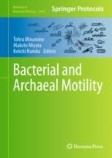Search
Search Results
-
Metabolite Analyses Using Nuclear Magnetic Resonance (NMR) Spectroscopy in Plasma of Patients with Prostate Cancer
Nuclear magnetic resonance (NMR) spectroscopy enables the detection and the quantification of a large range of molecules, including...
-
Probing Substrate-Loaded Carrier Proteins by Nuclear Magnetic Resonance
Carrier proteins (CPs) are central actors in nonribosomal peptide synthetases (NRPSs) as they interact with all catalytic domains, and because they...
-
Metabolomics Analysis of Urinary Extracellular Vesicles by Nuclear Magnetic Resonance and Liquid Chromatography–Mass Spectrometry
Extracellular vesicle (EV) release and their content are influenced by diverse clinical conditions. EVs participate in inter-cellular communication...
-
Detecting and Characterizing Interactions of Metabolites with Proteins by Saturation Transfer Difference Nuclear Magnetic Resonance (STD NMR) Spectroscopy
Saturation transfer difference (STD) nuclear magnetic resonance (NMR) spectroscopy is an established technique for detecting and characterizing the...
-
The Complementarity of Nuclear Magnetic Resonance and Native Mass Spectrometry in Probing Protein-Protein Interactions
Nuclear magnetic resonance (NMR) and native mass spectrometry (MS) are mature physicochemical techniques with long histories and important...
-
Type I Lipoteichoic Acid (LTA) Purification by Hydrophobic Interaction Chromatography and Structural Analysis by 2D Nuclear Magnetic Resonance (NMR) Spectroscopy
Type I lipoteichoic acid (LTA) is a glycerol phosphate polymer found in the cell envelope of diverse Gram-positive bacteria. The glycerol phosphate...
-
Determination of nuclear magnetic resonance surface relaxivity for the macropore system from wood cell lumen
To determine the surface relaxivity of pores plays a vital role in the application of time-domain nuclear magnetic resonance (TD-NMR) technology to...

-
Nuclear Magnetic Resonance Methods in Structural Characterization of Glycosaminoglycans
Glycosaminoglycans (GAGs) are sulfated glycans of complex structure and multiple biological actions. They are composed of disaccharide repeating...
-
Site-Specific Isotope Labeling of FliG for Studying Structural Dynamics Using Nuclear Magnetic Resonance Spectroscopy
To understand flagella-driven motility of bacteria, it is important to understand the structure and dynamics of the flagellar motor machinery. We...
-
Solution-state nuclear magnetic resonance spectroscopy of crystalline cellulosic materials using a direct dissolution ionic liquid electrolyte
Owing to its high sustainable production capacity, cellulose represents a valuable feedstock for the development of more sustainable alternatives to...

-
Metabolic Analysis of Intracellular Pathogenic Bacteria Using NMR
Pathogen proliferation and virulence depend on available nutrients, and these vary when the pathogen moves from outside of the host cell...
-
NMR Analysis of Mammalian Glycolipids
Mammalian glycolipids play a variety of roles, often coupled with interactions with endogenous and exogenous molecules. The interactions can induce...
-
Nuclear Magnetic Resonance Spectroscopy to Analyse Protein Folding and Dynamics
Proteins are nanoscale machines that perform all the work in living systems. Their function depends on their three-dimensional (3D) structure. These...
-
Measuring Phosphoglycolate Phosphatase Activity Using NMR Detection of Glycolate
Besides the historical and traditional use of nuclear magnetic resonance (NMR) spectroscopy as a structure elucidation tool for proteins and...
-
Nuclear Magnetic Resonance-Guided Structural Analysis of Moderate-Affinity Protein Complexes with Intrinsically Disordered Polypeptides
Binding affinity of an individual binding site of an intrinsically disordered protein for its folded partner may be moderate. In such cases, a...
-
Metabolic biomarkers using nuclear magnetic resonance metabolomics assay for the prediction of aging-related disease risk and mortality: a prospective, longitudinal, observational, cohort study based on the UK Biobank
The identification of metabolic biomarkers for aging-related diseases and mortality is of significant interest in the field of longevity. In this...

-
sRNA Structural Modeling Based on NMR Data
Small non-coding RNAs (sRNAs) play vital roles in gene expression regulation and RNA interference. To comprehend their molecular mechanisms and...
-
SDS-induced hexameric oligomerization of myotoxin-II from Bothrops asper assessed by sedimentation velocity and nuclear magnetic resonance
We report the solution behavior, oligomerization state, and structural details of myotoxin-II purified from the venom of Bothrops asper in the...

-
Nuclear Magnetic Resonance Spectroscopy in Food Analysis
Nuclear magnetic resonance (NMR) spectroscopy is a powerful spectroscopic technique, conventionally used for structure verification, elucidation, and...
-
Bone marrow plasma metabonomics of idiopathic acquired aplastic anemia patients using 1H nuclear magnetic resonance spectroscopy
IntroductionIdiopathic acquired aplastic anemia (AA) is a bone marrow failure disorder where aberrant T-cell functions lead to depletion of...

